Another April, another Game Jam: in fact, it was time for Ludum Dare 26. After the mixed experience that was this year’s Global Game Jam, I was curious to see if we were able to apply any of the lessons learned.
The theme of the Jam was “Minimalism”, which to me personally isn’t so much a theme as it is a design principle. Then again, it feels like our group usually uses the theme as a jumping-off point to come up with ideas, but doesn’t adhere to it too closely beyond that. It might be worth while to try to come up with an idea for a game next time before applying the theme to it, and thus avoid being too constrained initially.
Unlike last time around, we picked a game mechanic (Platformer) that all team members knew and understood early on. Changing details of a game later is easy, as long as everyone is aware of how the game is meant to play. Also, we were lucky to have a team member create artwork for us, which I think ultimately made the presentation much more impressive. I mean, come on, look at that guy:
On the technical side, we decided to use Gamemaker this time around after having used Crafty.js for the past two jams. Crafty wasn’t bad, but had some serious issues with sound and cross-browser performance, so we hoped to get a little more mileage out of the arguably more advanced Gamemaker. I had done some testing with it prior to the jam, and felt pretty comfortable that we could implement a 2D platformer.
After using it for a weekend-long project, I’ve come to the conclusion that I wouldn’t want to use it in the future. Like any tool there is a learning curve, which with Gamemaker is pleasantly gradual. You can either write code in a proprietary language (GML), or use a more graphic approach dragging actions and events onto game objects. However, I found that for most advanced goals, the graphical approach was too limited. Also mixing the two approaches can get confusing fast, since code can be hiding behind numerous event handlers. On multiple occasions I was reminded of coding in Visual Basic 6, which is not an experience I had hoped to never go back to.
Additionally, there were a lot of minor annoyances, such as inconsistent naming schemes and a fairly primitive language – call me picky, but automatic string conversion for primitive data types should be pretty standard for a programming language in 2013. And having multiple, different IDs per object per instance in both the Gamemaker editor, and then at runtime did make things way more complex than they need to be in my opinion.
As of right now, it looks like we (just like everyone else these days?) are gravitating towards Unity for our next jam, although I do feel that I want to give Construct 2 another look after hearing some good things about it.
At this point, I haven’t spent a lot of time looking at games other people made, but I will try to get around to that this weekend. If you’d like to check out the fruit of our labor, Molbert is available from the Ludum Dare page.

Leave a Reply